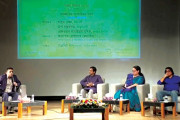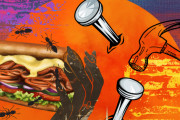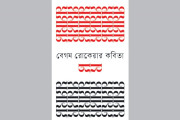।। Khandoker Montasir Hassan ।।
The most important lesson that the present-day readers can learn from these pandemic-related fictional works of the past is that pandemic isn’t something new and we have been through this before and we’ve survived. So, like the earlier days, we’ll go through COVID-19 and win
Today, during this global pandemic, the whole world is quarantined and trying to prevent the spread of COVID-19. We are stuck at home, unable to do our regular activities normally, and so distraught by the holocaust brought by this pandemic, deliverance from which is yet to be known. In such a period of uncertainty, literature can provide, at least, a temporary escape, relief, comfort and companionship, or a source of inspiration. Especially, the literature that flourished during or after those periods of uncertainty during the past pandemics give such a realistic picture that while reading, the readers may think that the writers wrote those literary pieces predicting our today’s pandemic. Since the outbreak of the COVID-19 many contemporary literary critics, writers, educators, scholars, professors of literature or editors of renowned literary journals and magazines have been revisiting those pieces of literary works that were based on past pandemics, ranging from the classics to contemporary novels to evaluate and interpret them from different perspectives afresh. Some of the critics are trying to compare the themes of those writings with the present days of uncertainties, some are trying to interpret some novels that they think the present-day readers may find them as a source of temporary comfort, or inspiration or, those novels might help them predict the future for what may happen next in the post-pandemic world. In fact, unlike the ordinary human beings, the poets or writers, with the help of their more sensitive powers, have articulated their reactions and experiences of the pandemics either as an observer or as a sufferer in different forms of genres that have flourished during, or after the outbreaks of the diseases for millennia.
The purpose of this present article is to evaluate and interpret some of those selected pieces of articles written by different critics, researchers, contemporary writers and professors of literature since the outbreak of the present COVID-19 based on the literary works that flourished during or after the past pandemics of the world for millennia. The ultimate aim is to put the things together with the expectation that these texts may give the readers an opportunity to think through how similar crises have been managed previously, as well as ideas about how we might structure our societies more equitably in their aftermath.
First among these countless novels as Riva, Benedetti & Cesana (2014) describe Jack London’s (1876–1916) novel The Scarlet Plague (1912), was one of the first examples of a post apocalyptic fiction novel in modern literature. In that novel London investigated many traditional issues of the literary topos of plague, ranging from a reflection on morality and justice to the contagion and clinical features of the disease. In particular, the author focused his attention on behavioral responses to a pandemic, showing the emergence of fear, irrationality, and selfishness in a previously civilized and modern society. In the novel, one of the few survivors, James Howard Smith, alias “Granser,” tells his incredulous and near-savage grandsons how the pandemic spread in the world and about the reactions of the people to contagion and death. Even though it was published more than a century ago, The Scarlet Plague feels contemporary because it allows modern readers to reflect on the worldwide fear of pandemics, a fear that remains very much alive even today, and it presents the same concerns we face today (Riva, Benedetti & Cesana, 2014).
However, unlike the brutality of plague and the way London presented in his novel, there are some novels that articulate a realistic picture of progression from the worst to normality. As Jane Ciabattari (2020) has written in an article in the ‘Book column for BBC Culture’ that there are many such novels that give a realistic chronological progression, from first signs through to the worst times, and the return of ‘normality’ and Daniel Defoe’s A Journal of the Plague Year (1722) is an example. Ciabattari describes, Defoe begins in September 1664, when rumours circulate of the return of ‘pestilence’ to Holland. Next comes the first suspicious death in London, in December, and then, come spring, Defoe describes how death notices posted in local parishes have taken an ominous rise. By July, the City of London enforces new rules, like the rules today in the days of COVID-19 now becoming routine in 2020 shutdown. By August, Defoe writes, the plague is “very violent and terrible”; by early September it reaches its worst, with “whole families and indeed whole streets of families… swept away together.” By December, “the contagion was exhausted, and also the winter weather came on apace, and the air was clear and cold, with sharp frosts… most of those that had fallen sick recovered, and the health of the city began to return. When at last the streets are repopulated, people went along the streets giving God thanks for their deliverance.”
After the plague, the pandemic that devastated and reshaped the whole world, leading to the loss of 50 million people, was the Influenza Pandemic in 1918 (also known, as the “Spanish flu”). Elizabeth Outka, a professor of literature at the University of Richmond opines in her article in The Paris Review that literature that arose from the influenza pandemic speaks to our current moment in profound ways, offering connections in precisely the realms where art excels: in emotional landscapes, in the ways a past moment reverberates into the present, in the ineffable conversation between the body’s experiences and our perception of the world’. The direct experience of 1918 pandemic of Anne Porter and the articulation of her experience in her novella “Pale Horse, Pale Rider” will definitely inspire the contemporary readers. In October of 1918, a delirious Katherine Anne Porter experienced what she termed “the beatific vision.” Close to death from the novel influenza virus that would kill 50–100 million people, Porter felt transported to a paradisal landscape, one free of the pain and fear that had overtaken her body. To the surprise of all, she survived her illness, and later transformed the experience into her powerful novella “Pale Horse, Pale Rider.” That story is one of the few literary works directly about the pandemic. The experience, Porter said, “simply divided my life … and after I was in some strange way altered … it took me a long time to go out and live in the world again.” How horrible the experience was the fact that Porter, at last survived, description of the devastation created by the Spanish flu in her novel definitely feels familiar to present day’s COVID-19 pandemic. “It’s as bad as anything can be… all the theatres and nearly all the shops and restaurants are closed, and the streets have been full of funerals all day and ambulances all night”, heroine Miranda’s friend Adam tells her shortly after she is diagnosed with influenza.
Next, the novelist who most realistically and successfully depicted the terror of 1918 pandemic’s experience was Virginia Woolf who survived the pandemic and lived to write about it. Virginia Woolf, who suffered heart damage from her encounter with the flu, conferred her resulting debilitation on the title character of her novel, “Mrs Dalloway” (1925). Evan Kindley has very skillfully argued in her article “Why Anxious Readers under Quarantine Turn to “Mrs. Dalloway.” Reading “Mrs. Dalloway” as, at least in part, “a novel devoted to influenza” puts Clarissa’s pleasure in traversing the city in a new light. So does reading it in the midst of our own pandemic, which has temporarily dissolved the busy urban scenes Woolf describes so lovingly throughout her book. For Clarissa, London is animated by “divine vitality”: its density and crowding—precisely what would have made it deadly in 1918—are seen as signs of life.
Maria Prova, a contemporary writer has rightly written, no one has articulated the peculiar vexations of illness, nor addressed the psychic transcendence accessible amid terrors of the body, more thoughtfully than Virginia Woolf in her 1926 essay “On Being Ill.”
“Considering how common illness is, how tremendous the spiritual change that it brings, how astonishing, when the lights of health go down, the undiscovered countries that are then disclosed… it becomes strange indeed that illness has not taken its place with love and battle and jealousy among the prime themes of literature.”
How the life of the body shapes the life of the mind is skillfully described in the essay:
“All day, all night the body intervenes; blunts or sharpens, colours or discolours, turns to wax in the warmth of June, hardens to tallow in the murk of February………………….. Short of these, this monster, the body, this miracle, its pain, will soon make us taper into mysticism, or rise, with rapid beats of the wings, into the raptures of transcendentalism.”
Expecting ‘illness’ to be the subject of literature Woolf writes:
“To hinder the description of illness in literature, there is the poverty of the language. English, which can express the thoughts of Hamlet and the tragedy of Lear, has no words for the shiver and the headache. It has all grown one way.”
In another article, Elizabeth Outka argues that traces of the psychological effects of the 1918-20 flu pandemic can also be detected in works of the inter-war period written by other survivors. She sees the shadow of the virus in T.S. Eliot’s “The Waste Land” (1922), in which death can seem ever-present:
Under the brown fog of a winter dawn,
A crowd flowed over London Bridge, so many,
I had not thought death had undone so many.
Outka writes: the uncertainty rises, too, from the invisibility of the enemy. The consciousness is tuned to a threat that might be everywhere but cannot be seen. A world of surfaces and people become suspect, the body porous and vulnerable. W. B. Yeats captures this sense of menace in “The Second Coming,” a poem composed in the weeks after he watched his pregnant wife come close to death in the pandemic. The Waste Land and “The Second Coming,” read through the lens of a body’s internal delirium, record hallucinatory realities, fragmented perception, the burning pain of fever and ache.
Thus, some of the themes recurred over the centuries in the pieces of genres by different writers and the past pandemics have always left their marks on writers that they have articulated in their writings from Homer’s Iliad and Boccaccio’s Decameron to the 20th century writers like Albert Camus’ The Plague (1942) or Stephen King’s The Stand (1978) and have always brought readers’ attentions. In Stephen King’s novel The Stand (1978) a bioengineered superflu named “Project Blue” leaks out of an American military base. Pandemonium ensues. But what makes us hopeful is that Stephen King himself has stated on Twitter that COVID-19 is certainly not as serious as his fictional pandemic. He wrote “It’s (COVID-19) not anywhere near as serious. It’s eminently survivable. Keep calm and take all reasonable precautions.”
Now, synthesising the areas of inquiry, we will try to identify what lessons we can learn from the above mentioned writing that can inspire the present day readers. At first, in the first novel The Scarlet Plague as London shows pandemics can bring forth deeply rooted fears and modify human behavior greatly. By this time it has become obvious to us that the COVID-19 fear has also changed human behavior greatly maybe not as much frightening way as London showed but it has changed. The next point, London raised a harsh critique against the society that is seen as the ultimate cause of the world’s destruction. In particular, in London’s opinion, capitalism led to the rise in population and to overcrowding, and overcrowding led to plague. Consequently, capitalism is presented as the ultimate cause of the pandemic and thus harshly criticized. Even after a century, the same criticism repeats as in a recently published newspaper article a Bangladeshi educationist Professor Mijanur Rahman has written that the present COVID-19 has nakedly exposed the hollowness of capitalism. Another similarity of the novel with the present day crisis is that in London’s time the people appeared not to be alarmed because they “were sure that the bacteriologists would find a way to overcome this new germ, just as they had overcome other germs in the past.” But ultimately it failed. Thus, the defeat of the science and medicine in which the people had placed trust generated fear in the population even today. But unlike London’s novel, like Defoe, may be the present day readers would also expect their deliverance from the pandemic soon.
Similarly, like Katherine Anne Porter who almost died from the plague of influenza herself. “I was in some strange way altered,” she told The Paris Review in a 1963 interview. “It took me a long time to go out and live in the world again. I was really ‘alienated’ in the pure sense.” This experience can only be felt by those who incredibly survived fighting against the unbearable sufferings caused by the invisible enemy, COVID-19, and obviously like Porter it will take a long time for them to go out and live in a new world.
The way Kindley describes her feeling of rereading “Mrs. Dalloway” will definitely turn the readers under COVID-19 Quarantine to “Mrs. Dalloway” as she writes: “When I reread the novel recently, this passage, which has always thrilled me, had an even stronger charge. Woolf’s vivid description of a crowded metropolis right now, when our own cities’ streets lie empty, feels like something out of a fantasy novel. Yet Clarissa’s joie de vivre is mixed with a sense of latent dread: “she always had the feeling that it was very, very dangerous to live even one day.”
Thus, the themes of survival from almost death, isolation, terror and brutality of an invisible enemy, failure of authority, medicine and science to overcome the terror, reaction of the community and love — all are predicted in those writings. All these writings mainly offered much in the way of catharsis, ways of processing strong emotion, and political commentary on how human beings respond to public health crises. However, as Jane Ciabattari remarks that our own current situation is, of course, nowhere near as extreme as the one in The Scarlet Plague or Katherine Anne Porter or the sufferers of the 1918 pandemic when the virus routinely drowned people in their beds as their lungs filled with fluids, and it caused sudden bleeding from the nose, mouth, and ears. But, one thing is definitely similar that like the past pandemics’ sufferers our own bodies are also busy now, they are recording our pandemic, setting in place the reverberations that will echo in future.
Thus, by this time, one thing has become clear to all that if we were to remain alive, we have to adjust ourselves to the new realities in a post-pandemic world. So, maybe for a time being we have lost the regular or ordinary courses of action, there is no chance to prolong it. As we don’t have any other choice than to ‘redefine’ the term ‘action’ itself as it looks like in our current circumstances. And, thus, the most important lesson that the present day readers can learn from these pandemic fictional works of the past is that pandemic isn’t something new and we have been through this before and we’ve survived. So, like the earlier days we’ll go through it and we’ll survive. What we need to learn is how to adjust ourselves and how to redefine the term ‘action’ itself as it looks like in our current circumstances to cope up with the new realities of life in a post-pandemic world. We have to accept the reality. Tennyson says:
“The old order changeth yielding place to new,
And God fulfils Himself in many ways,
Lest one good custom should corrupt the world”
The writer is Associate Professor of English, Institute of Modern Languages (IML), Jagannath University, Dhaka. E-mail: montasirjnu@gmail.com










































































































































































